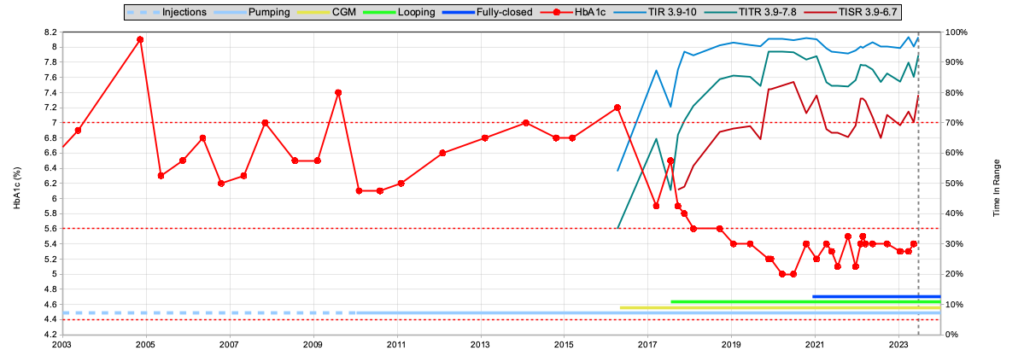In the last article I discussed what I think is a remarkable comparison between my recent personal data and the output of a 2019 CGM study of people without diabetes.
At the end I showed a graph stretching over 20 years. It shows my HbA1c results over that time, overlaid with the TIR data from when I started using CGMs in 2016, and with bars at the bottom indicating the management tools I was using.
My recent results have been using a “fully closed loop” AID system (as distinct from “hybrid closed loop” where I don’t announce food at all. That’s represented by the solid blue line at the bottom (since the start of 2021).
What was going on in 2020?
But when we go back to mid-2020 we can see that I was already getting percentage-in-range data similar to now! So I went back to look at that data. In June 2020 I was using Fiasp insulin, and running in a “hybrid” mode, where I counted and declared all food. I think it’s interesting to compare the results.

| “Non-diabetic” aged 25–59 |
David June 2023 |
David June 2020 |
|
| People | n=41 | n=1 | n=1 |
| Days sampled | 3 – 10 each | 12 | 60 |
| Hours of CGM use | 207 (± 25) Between 136– 245 |
288 (100%) |
1424 (98.9%) |
| TAR (>10 mmol/L) | 0% | 0.4% | 0.4% |
| TIR | 99% | 98.3% | 97.3% |
| TITR | 97% (94 – 98%) |
92.3% | 93.3% |
| TISR | 89% (86 – 91%) |
79.2% | 83.5% |
| TBR (<3.9 mmol/L) | 1.0% (0.3 – 2.3%) |
1.3% | 2.3% |
| <3.5 mmol/L | 0.1% | 0.6% | |
| <3.0 mmol/L | 0.0% (0.0 – 0.2%) |
0.0% | 0.0% |
| eHbA1c / GMI | 5.1% (± 0.2%) / 5.7% (~± 0.2) | 5.2% / 5.7% | 5.2% / 5.7% |
| Lab HbA1c | n/a | ? | 5.0% |
| Coefficient of Variation (CV) | 16% (± 3%) | 22% | 20% |
The take-aways I find in this:
- I got similar results back then to now. Even in a larger sample set.
- Higher TISR even. I wasn’t measuring against that range then, but I was paying a lot more attention to everything.
- In fact I recall I was having to work a lot harder at it!
- My time below 3.9 was higher, but again most of that was between 3.5-3.8 (“just south of the border”).
There was more time below 3.5 though.
My statistical results definitely took a hit when I let the system take over, but I’m happy that it looks like I’m getting back towards those levels!
Daytime/Nighttime comparisons
I see that “non-diabetic” paper further split the data into “daytime” (06:00 – 23:59) and “nighttime” (00:00 – 05:59). It was only a few moments’ work to do the same for my recent data. That time split is fairly arbitrary (I’m often still up at midnight for example) but I thought I’d see how the comparison looked for the recent 12-day sample.
| Daytime 06:00 – 23:59 |
Nighttime 00:00 – 05:59 |
||||
| David June 2023 |
“Non-diabetic” | David June 2023 |
“Non-diabetic” | ||
| TAR (>10 mmol/L) |
0.5% | 0.0% (0.0 – 0.2%) |
0.2% | 0.0% (0.0 – 0.2%) |
|
| TIR | 98.3% | 99% | 98.3% | 99% | |
| TITR | 91.9% | 96% (93 – 97%) |
93.8% | 97% (94 – 98%) |
|
| TISR | 76.7% | 87% (84 – 90%) |
87.0% | 89% (86 – 91%) |
|
| TBR (<3.9 mmol/L) |
1.2% | 1.3% (0.3 – 2.5%) |
1.5% | 1.0% (0.3 – 2.3%) |
|
| Average BG (mmol/L) |
5.8 | 5.5 (~± 0.3) | 5.5 | 5.4 (~± 0.4) | |
| CV | 22% | 17% (± 3%) | 20% | 12% (± 4%) | |
Not surprisingly, my overnight stats look a lot cleaner than my daytime stats. Except there was a slightly higher percentage below 3.9. Not really surprising in this short run though. Overall my nighttime stats did move closer towards those “non-diabetic” numbers.
I don’t really see lots of value in looking at these arbitrary “day vs night” windows separately, but I was curious as to how it compared to the split as done in that “non-diabetic” study.

